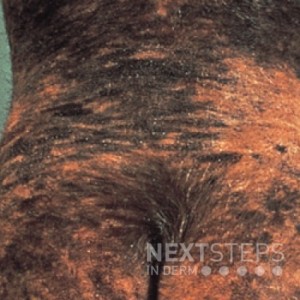
The correct answer is C. Neurocutaneous melanosis.
This is a giant congenital melanocytic nevus (GCMN), which is associated with neurocutaneous melanosis. GCMN overlying the spinal column and skull or multiple satellite lesions can be associated with neurocutaneous melanosis (symptoms of increased cranial pressure, spinal cord compression or leptomeningeal melanoma) Symptomatic neurocutaneous melanosis has a poor prognosis (50% develop leptomeningeal melanoma). These children need an MRI to rule-out CNS involvement.
Deafness is seen in LEOPARD, KID, Muckle-Wells, Cockayne, Cornelia de Lange, and Bjornstad syndromes. Cataracts can occur in Rubella, Rothmund-Thomson Syndrome, IBIDS Syndrome, IP, Cockayne syndrome, and Rothmund Thompson syndrome. Limb length discrepancy is seen in Klippel-Trenaunay syndrome. Brachydactyly is seen in Rubenstein-Taybi.
References:
Barbagallo JS, et al. Neurocutaneous disorders. In JP Callen, Ed. Dermatol Clin. Philadelphia: Saunders, 2002;547-560.
Zvulunov A, Esterly NB. Neurocutaneous syndromes associated with pigmentary skin lesions. J Am Acad Dermatol 1995; 32: 915-35.
